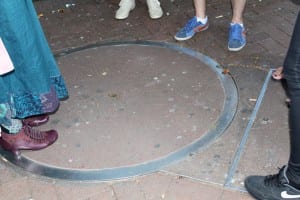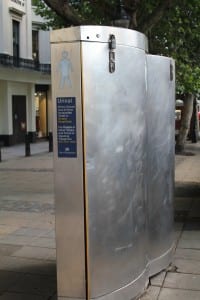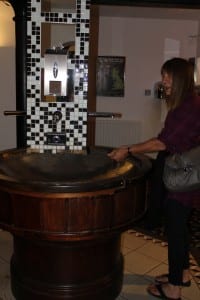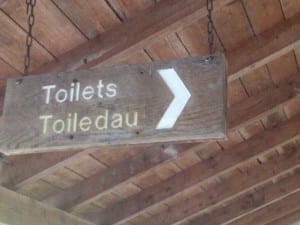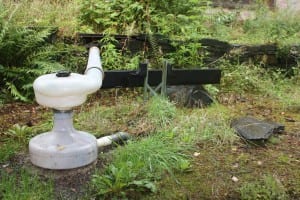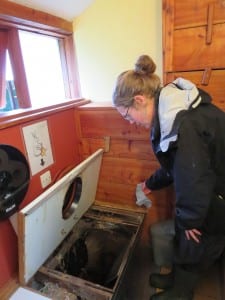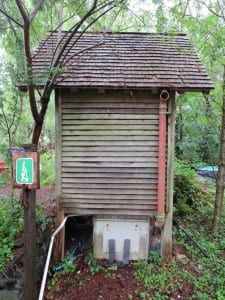London loves loos: the Loo Tour
By ucesbar, on 23 September 2013
A couple of members of the project team recently took the London Loo Tour, in preparation for the UCLoo Festival taking place 19th November – 3rd December at UCL’s Main Quad (please donate – just £5 or less will help – to make sure this event happens: http://spacehive.com/ucloofestival2013 But hurry – we must reach our fundraising target by 17th October!)
We started at Waterloo Station where Rachel the Loo Tour Lady was easy to spot, toilet plunger in hand. Originally starting her loo research as a student trying to avoid fee-charging public toilets, Rachel now runs weekly walking tours around the City and will soon be branching out into additional areas, including a special Bloomsbury Loo Tour during the UCLoo Festival (booking info below: details of the UCLoo tours to be announced soon).
As one of the few public amenities in London allowed to charge a fee for use of their toilets, I was surprised by my own visit to find the Waterloo Station ladies’ room somewhat grim. Our guide informed us that it costs upwards of £20,000 per year to maintain a public toilet facility, but we were unable to determine how much the toilet fees amount to.
The second stop, and a much more spectacular one, was the Jubiloo public toilets at the Southbank Centre. Built for the Queen’s Diamond Jubilee and designed by architect Mark Power, the toilet costs 50p per use (compared with the station’s 30p charge) and has full-time attendants (hard to miss in their Union Jack waistcoats!) It also makes use of rainwater to flush toilets and wash floors.
To pay or not to pay? This is an essential question that constantly comes up in toilet politics. Rachel explained that boroughs are not, in fact, obligated to provide public conveniences – and many don’t these days. Our next stop was across the Thames near Embankment Station, where we came to an example of a public convenience which was privatized by Westminster in 2012 – like all conveniences in that borough – and also charges a princely 50p. On the up side, it was one that offers facilities for those with a range of disabilities and includes a hoist for wheelchair users.
Just around the corner outside Embankment Garden, we stood on top of the mysterious “Urilift” –one of three urinals, also provided by Westminster, that rise from the ground in the evenings to offer an alternative option for late-night male revellers.
Another, more permanent example of a street urinal was the Butterfly, outside of Charing Cross Station. The slick stainless steel design offers minimal privacy but hopes to prevent weeing on the street.
Next we visited the underground toilets at St. Paul’s, Covent Garden. Rachel expanded on the difficulties of providing public conveniences for women in the Victorian Era. She particularly mentioned one case: a proposed toilet for women in Camden Town, which was championed by none other than George Bernard Shaw (then a local vestryman) for many years. Female toilets were highly controversial (many people thought they were an ‘abomination’ and would be filled by flower girls cleaning their watercress) and the most successful were the ones that were discretely located underground. Toilets for gentlemen were far more appreciated elements of the cityscape. The gentleman’s loos at the Royal Exchange even had a sonnet dedicated to them.
Just off Covent Garden, we traversed the narrow Brydges Place alleyway. As prime territory for late-night weeing, it’s estimated that the streets of London are subjected to 10,000 gallons of urine per year; one contributor felt the need to apologise.
Next stop was the underground Cellar Door Cabaret – a bar and nightclub built inside a former men’s toilet. Once visited by Oscar Wilde and Joe Orton, the location now hosts only two cubicles, making use of “Smart Glass” which turns from transparent to opaque when the door is locked. We stopped for refreshments (and a toilet break) before continuing the walk. Nearby, another piece of toilet history was viewed at the mint green Star Yard urinal; maybe the only cast-iron Victorian model remaining in the City.
The cramped quarters of the urinal was in stark contrast with the enormous, lounge-like ladies’ loo in The Knights Templar pub, our next visit, which contained multiple chambers; bronze and tiled hand-washing facilities and even couches. Other pub stops included a Community Loo Scheme participant; Ye Olde London is one of 75 establishments paid £600 each yearly by the City of London to allow the public to make use of their toilets without needing to make a purchase. Unfortunately, the sign in the window was barely noticeable, and the scheme doesn’t seem especially well-publicised.
Our second-to-last stop was the free toilets of St. Paul’s Cathedral, winner of the Loo of the Year Award in 1995 despite the continued use of original plumbing. And finally, the tour ended on a high note at the rooftop patio of One New Change. Although we didn’t see any noteworthy toilets, the beautiful view across London was a perfect spot to contemplate the rich history of loos in London.
With impressive historical knowledge and a great sense of humour, Rachel’s Loo Tours are well worth a visit. You can book yours at:
http://lootours.com/tours/ucloo-tour.html
There will be special UCL campus and wider Bloomsbury tours available to book during the UCLoo Festival, taking place 19th November to 3rd December.
For more photos and to see a short video of the Loo Tour Lady explaining the idea behind her project, please visit our Facebook and Twitter accounts: www.facebook.com/ucloofestival @UCLooFestival.
 Close
Close



